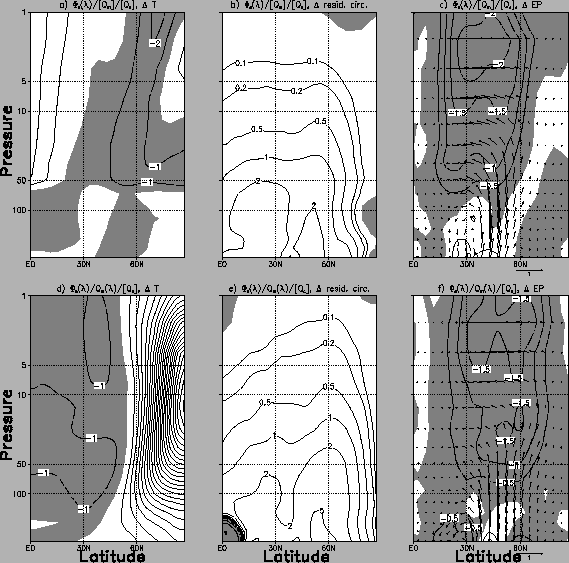Previous: Annular Modes in the surface pressure Next: Conclusions Up: Ext. Abst.
The stratospheric Arctic Oscillation
For run
![]() , Fig. 3 shows the first EOF of the 50hPa-geopotential and one-point correlation
maps for two reference points. All three patterns consist of a
comparably strong zonal symmetry and a high pattern correlation
( for a and b: -0.9, for a and c: 0.65). Furthermore, the correlations
between first principle components of 50hPa-geopotential and either
50hPa-zonal wind or 50hPa-temperature reach values greater than
0.9. These results and the high explained variance of the first
50hPa-geopotential EOF (41.6%) seems to indicate that this EOF
represents a physically meaningful variability pattern.
, Fig. 3 shows the first EOF of the 50hPa-geopotential and one-point correlation
maps for two reference points. All three patterns consist of a
comparably strong zonal symmetry and a high pattern correlation
( for a and b: -0.9, for a and c: 0.65). Furthermore, the correlations
between first principle components of 50hPa-geopotential and either
50hPa-zonal wind or 50hPa-temperature reach values greater than
0.9. These results and the high explained variance of the first
50hPa-geopotential EOF (41.6%) seems to indicate that this EOF
represents a physically meaningful variability pattern.
 |
For different stationary wave forcing, the leading EOFs of the
50hPa-geopotential show different features. In particular, in
run
![]() and run
and run
![]() (Figs. 4a,b), the leading EOFs have strong wave components, whereas predominantly
zonally symmetric patterns are obtained in run
(Figs. 4a,b), the leading EOFs have strong wave components, whereas predominantly
zonally symmetric patterns are obtained in run
![]() , run
, run
![]() (Figs. 4c,d) and run
(Figs. 4c,d) and run
![]() (not shown).
(not shown).
But only run
![]() and run
and run
![]() do generate AO patterns (Figs. 4c,d) that agree reasonably well with observational data (Thompson
and Wallace, 2000). This holds for structure as well as explained
variance (here: 41.6% and 41.1%, theirs: 54%). In the other runs
such a mode cannot be found even in the higher EOFs. Therefore,
the combination of orographic and middle latitude thermal wave
forcing seems to be imperative for the activation of an AO-like
variability pattern in the stratosphere. Thermal wave forcing
in the tropics does not contribute conspicuously to this variability
mode in our model.
do generate AO patterns (Figs. 4c,d) that agree reasonably well with observational data (Thompson
and Wallace, 2000). This holds for structure as well as explained
variance (here: 41.6% and 41.1%, theirs: 54%). In the other runs
such a mode cannot be found even in the higher EOFs. Therefore,
the combination of orographic and middle latitude thermal wave
forcing seems to be imperative for the activation of an AO-like
variability pattern in the stratosphere. Thermal wave forcing
in the tropics does not contribute conspicuously to this variability
mode in our model.
 |
Using the first principle component of the 50hPa-geopotential, a composite analysis is carried out with 10% of the days with the lowest and highest values of the principle component. In a negative (positive) phase an anomalous high (low) geopotential prevails at the pole, together with a weakened (strengthened) polar vortex. We call the ensemble difference between the negative and positive phase the stratospheric phase anomaly. In the following, we discuss its zonal-mean fields focussing on the runs with orographic and middle latitude thermal stationary wave forcing.
 |
In run
![]() , phase anomalies of temperature (Fig. 5d) and residual mass circulation (Fig. 5e) prove that, during the negative phase, the anomalous weak polar
vortex coincides with a warming of the polar stratosphere and
an enhanced residual circulation. No such relation exists, if
only one forcing mechanism is present (run
, phase anomalies of temperature (Fig. 5d) and residual mass circulation (Fig. 5e) prove that, during the negative phase, the anomalous weak polar
vortex coincides with a warming of the polar stratosphere and
an enhanced residual circulation. No such relation exists, if
only one forcing mechanism is present (run
![]() (not shown) and run
(not shown) and run
![]() (Figs. 5a,b)). In those runs we rather find that an anomalous weak polar
vortex is accompanied by cooling in high latitudes and warming
in the subtropical stratosphere, while the residual circulation
amplifies weakly.
(Figs. 5a,b)). In those runs we rather find that an anomalous weak polar
vortex is accompanied by cooling in high latitudes and warming
in the subtropical stratosphere, while the residual circulation
amplifies weakly.
The anomalous Eliassen-Palm(EP)-flux divergence in run
![]() (Fig. 5f) indicates an enhanced planetary wave activity in the polar
night stratosphere during the negative phase. Even though such
a phase anomaly is principally also observed in run
(Fig. 5f) indicates an enhanced planetary wave activity in the polar
night stratosphere during the negative phase. Even though such
a phase anomaly is principally also observed in run
![]() (Fig. 5c) and run
(Fig. 5c) and run
![]() (not shown), the effect is weaker and concentrates in subtropical
latitudes.
(not shown), the effect is weaker and concentrates in subtropical
latitudes.